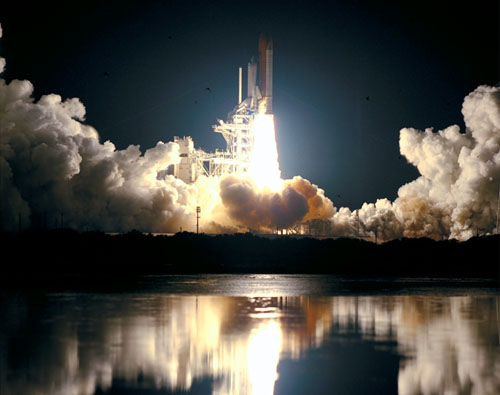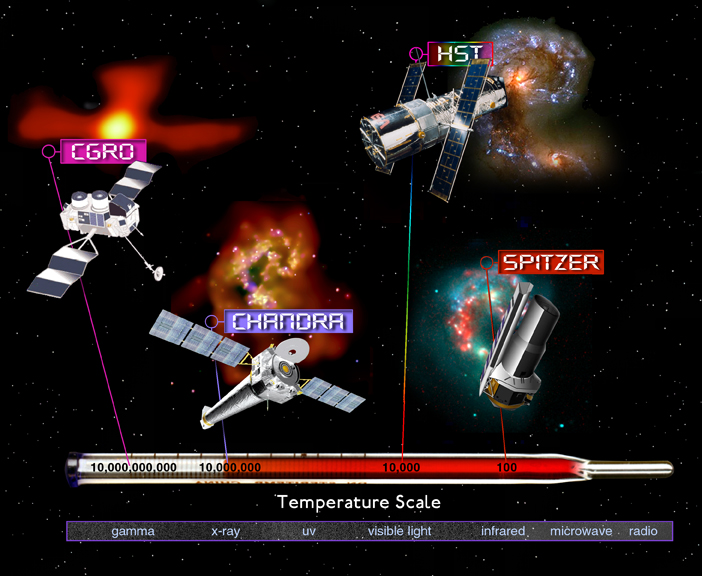General
Heads Up! Avoiding Collisions in Space
Recently, the Fermi team announced that the spacecraft dodged a very large bullet in the form of a defunct Soviet spy satellite: https://www.nasa.gov/mission_pages/GLAST/news/bullet-dodge.html. The close encounter with Cosmos 1805 was reminder that even though space is very large, there are some real threats to our invaluable telescopes that are in orbit.
Wonder and Sublime in Space Imagery
An interdisciplinary and international group from Chandra, the Smithsonian Astrophysical Observatory, and experts in the field of aesthetics from the University of Otago, New Zealand, formed the Aesthetics and Astronomy group - known as the A&A project -- back in 2008 to explore how astronomy images are perceived.
Amanda Berry, an MFA graduate student at Kendall College of Art and Design in Michigan, is researching "space" as a visual knowledge field. She asked some great questions to the Aesthetics & Astronomy project, which Jeffrey Smith kindly answered. We thought you might enjoy the read:
Chandra in 2012: A Teenager in Space
In July of 2012, Chandra completed its 13th year of operation, making it a teenager. That is young in human terms, but it is getting up there for an automobile, and could be considered a "senior citizen" for a spacecraft of Chandra's complexity. How many computers do you have that are 13 years old? Chandra's magnificent sister NASA flagship observatory, Hubble, is older, at 22, but astronauts have paid 4 house calls to make major upgrades over the years.
Understanding What's Out There by Looking Down Here
As we've talked about before, science doesn't recognize boundaries. (In fact, we've created the Here, There, Everywhere project to explore this very idea.) Often, scientists need to do experiments here on Earth to better understand what's happening billions of miles away across the Universe.
Thanks for Everything, Atlantis and Endeavor

As the human spaceflight plans at NASA transition away from the Shuttle program, there have been lots of goodbyes. And hellos. Recently, both the Space Shuttles Atlantis and Endeavor found new permanent homes in their post-flight lives. Atlantis is now at the Kennedy Space Center Visitor Center in Florida, and Endeavor will be found from now on at the California Science Center in Los Angeles.
At each location, NASA held a welcome home/retirement party for the Shuttles. As we've talked about before , the Shuttle program did so much more than just take people into space (which, of course, is a very important job). It also delivered many unique and important telescopes and instruments into orbit – including the Chandra X-ray Observatory.
Spirals Everywhere
This week's Hurricane Sandy got us thinking about spirals. Most of us have seen images of hurricanes from above – either photos from airplanes or radar taken with satellites.

A Space Jigsaw Puzzle: Coordinating Chandra With Other Telescopes
In July 2012, an event took place that gives us a chance to talk about several important aspects of Chandra observations involving coordination with other observatories, how they are done, and how they fit into the bigger picture of astronomical research.

Coordinated observations are those that must be done by Chandra and one or more other observatories at approximately the same time. Astronomers often want to study objects with multiple observatories because their different capabilities --- especially in detecting different regions of the electromagnetic spectrum --- can provide insight that no single observatory can do alone. The need for coordination in time comes because so many objects in space vary over time. That means that observations taken too far apart could be less valuable because the object has changed substantially in the meantime. It's often important for all observatories involved to catch the object during a particular celestial event. In the current annual cycle, Chandra's 13th , for example, about 10% of the approved observations request coordination with another observatory.
Going Back to School
This week marks the return to school for most kids (if they haven't been there for a week or more already). The post-Labor Day week got us thinking about school and education as it relates to Chandra and X-ray astrophysics.

"Here, There, and Everywhere" Makes its Debut
Today marks the launch of a new project – both physically and virtually. We are so happy to announce that "Here, There, and Everywhere" (known by the acronym of HTE) has officially debuted.
You may have heard this question, or asked it yourself: why bother studying things that are millions or billions of miles away in space? HTE, among other things, is a project that addresses that question.
Remembering the Original Chandra
On August 21, 1995, the field of astrophysics lost one of its greats. Seventeen years ago this week, Subrahmanyan Chandrasekhar passed away. Chandra, as he was known to his friends and colleagues, was widely regarded as one of the foremost astrophysicists of the 20th century.

